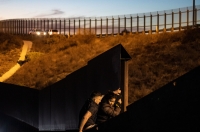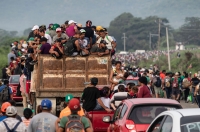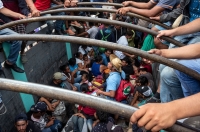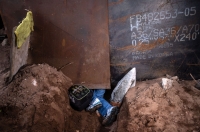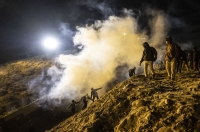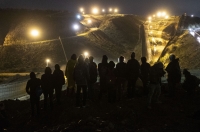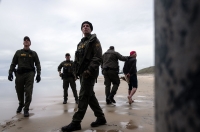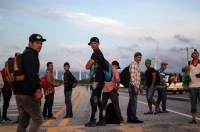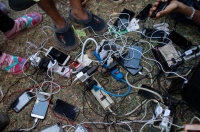Telling the story as it is
AFP photographer Guillermo Arias has won the top prize at photojournalism’s biggest annual festival, the “Visa Pour L’Image,” for his moving coverage of Central American migrants trying to get into the US.
Here Arias, who is based in Tijuana, Mexico and who scooped up the Visa d’Or for News, speaks about the importance of telling a story as honestly and completely and with as little manipulation as possible, especially in the age of ‘fake news’ and deep mistrust of the media.
Tijuana, Mexico -- I had been wanting to attend the Perpignan festival for years. It’s considered the profession’s most prestigious festival and to win the top prize… and for a subject so close to my heart… it’s a dream come true.
I won for my images of the historic caravan of Central American migrants who made their way through Mexico trying to reach the United States.
I’ve been covering people trying to get into the US promise land for years. But the 2018 caravan stood out because the migrants spontaneously formed a single group. These people are so exposed and vulnerable, especially to the gangs and other criminals who rule much of Mexico and other Central American countries. One in four women are raped. The rapes are so common that aid organizations distribute a kit with a “morning-after” pill to avoid unwanted pregnancies.
In the fall of 2018, people fleeing San Pedro Sula in Honduras decided to stick together as they left one of the world’s most dangerous cities for the promises of a better life in the US. As they moved north, more and more migrants joined them. The “migrant caravan” was born.
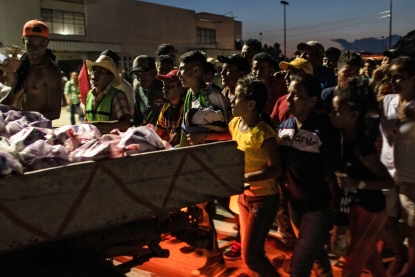 Honduran migrants taking part in a caravan heading to the US, walk behind a truck loaded with food at a temporary shelter in Juchitan de Zaragoza, Oaxaca state, Mexico, on October 30, 2018. (AFP / Guillermo Arias)
Honduran migrants taking part in a caravan heading to the US, walk behind a truck loaded with food at a temporary shelter in Juchitan de Zaragoza, Oaxaca state, Mexico, on October 30, 2018. (AFP / Guillermo Arias)During my years of covering the issue, there have always been groups who have made the perilous journey together. But never before have we had such numbers. By the end of October, it counted up to 7,000 people, according to some estimates.
One of the photos that made the most impact is one that I took from a drone on October 27.
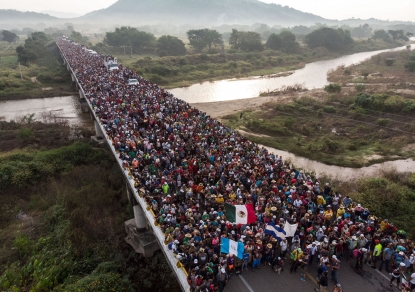 Aerial view of Honduran migrants heading in a caravan to the US, as the leave Arriaga on their way to San Pedro Tapanatepec, in southern Mexico on October 27, 2018. (AFP / Guillermo Arias)
Aerial view of Honduran migrants heading in a caravan to the US, as the leave Arriaga on their way to San Pedro Tapanatepec, in southern Mexico on October 27, 2018. (AFP / Guillermo Arias)The police had blocked the road for a few hours, so the group had gathered together in one spot. The image really shows the scale and it was the last time that we have been able to make a picture like that. I think that was the moment that US President Donald Trump began to talk about “an invasion.” When I made the photo, these people had already crossed three borders.
Many Gang Members and some very bad people are mixed into the Caravan heading to our Southern Border. Please go back, you will not be admitted into the United States unless you go through the legal process. This is an invasion of our Country and our Military is waiting for you!
— Donald J. Trump (@realDonaldTrump) October 29, 2018
One of my favorite pictures, also taken with a drone, is the one above a basketball court. To me it’s a very intimate moment without been too invasive, that really gives a sense of what this trip was like for these people -- basically they walked along the road and rested any place they found. Luckily for my pictures, this particular basketball court wasn’t covered and was freshly painted, so you can tell right away what it was.
 In this aerial file photo taken on October 28, 2018 of Honduran migrants heading in a caravan to the US, resting in a basketball pitch in San Pedro Tapanatepec, Oaxaca state, southern Mexico. (AFP / Guillermo Arias)
In this aerial file photo taken on October 28, 2018 of Honduran migrants heading in a caravan to the US, resting in a basketball pitch in San Pedro Tapanatepec, Oaxaca state, southern Mexico. (AFP / Guillermo Arias)The images of children crossing are so often heart-breaking, because they are often so scared. I can’t help but think what these kids will feel when they grow up. Will they resent having had to experience such things? I wonder if they understand why their parents have risked so much to bring them here.
 Children cry as a group of Central American migrants surrender to US Border Patrol agents after jumping over the metal barrier separating Playas de Tijuana in Mexico from the United States, on December 2, 2018, as seen from Playas de Tijuana. (AFP / Guillermo Arias)
Children cry as a group of Central American migrants surrender to US Border Patrol agents after jumping over the metal barrier separating Playas de Tijuana in Mexico from the United States, on December 2, 2018, as seen from Playas de Tijuana. (AFP / Guillermo Arias)Why have you come here? Getting people to answer this question is like peeling an onion. At first, most people answer “for a better life.” But if you ask for details, you realize that most are fleeing very violent circumstances and very serious threats. They’ll talk to you and then all of the sudden will say “Look” and lift up their shirts. And you see scars from bullets or knife wounds.
A few conversations like that and it becomes quite obvious that the common denominator here is extreme violence and poverty. I remember one woman from Honduras who had four teenage daughters. One day, one of the local gang members noticed the eldest daughter. That’s when she decided to leave. “If I don’t go with all of my daughters, I will end up losing them to the gangs,” she told me. I knew exactly what she meant. But as she spoke, I wondered “how do you prove something like that to an immigration judge?”
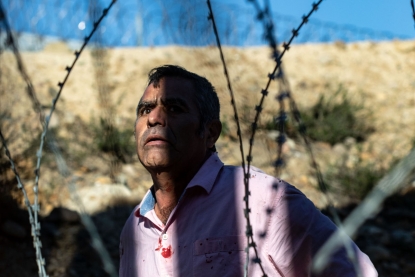 A Mexican migrant gets stuck in barbed wire shortly after crossing the US-Mexico border fence from Tijuana to San Diego County in the US as seen from Tijuana, Baja California State, Mexico, on December 28, 2018. (AFP / Guillermo Arias)
A Mexican migrant gets stuck in barbed wire shortly after crossing the US-Mexico border fence from Tijuana to San Diego County in the US as seen from Tijuana, Baja California State, Mexico, on December 28, 2018. (AFP / Guillermo Arias)Another image that I like very much is the one of the boy wrapped in the US flag, looking out onto border patrol vehicles, barbed wire and the border barrier in front of him. I took the image on November 25, the first time that there was an attempt at a mass border crossing. There are many impressive images from that day. I took this one toward the end. To me, it really sums up the essential -- you are not welcome, even if you have wrapped yourself into the idea of America. Many of these migrants have come here with their idea of the American dream, but America does not want them.
At the same time, the American dream that these people have often does not reflect reality. I live in Tijuana, where lots of Americans have migrated to because they can no longer afford to live around San Diego, just across the border.
 In this file photo taken on November 25, 2018 a Central American migrant wrapped in a US flag looks at the almost dry riverbed of the Tijuana River near the El Chaparral border crossing near US-Mexico border in Tijuana, Baja California State, Mexico. (AFP / Guillermo Arias)
In this file photo taken on November 25, 2018 a Central American migrant wrapped in a US flag looks at the almost dry riverbed of the Tijuana River near the El Chaparral border crossing near US-Mexico border in Tijuana, Baja California State, Mexico. (AFP / Guillermo Arias)When I work, I leave myself open to experience emotions, while at the same time trying to take a few steps back. I like to give as much context as I can, so that each of my pictures provides another piece to the story that I’m covering, like pieces of a jigsaw puzzle. Someone crying will always be a powerful image, but it won’t necessarily tell the entire story...
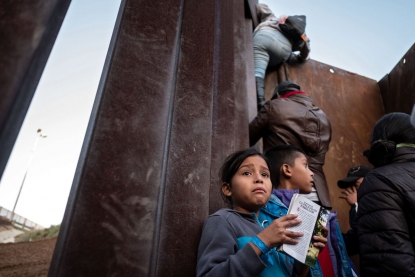 A Central American migrant girl holds a book as other migrants travelling in a caravan, climb the Mexico-US border fence in an attempt to cross to San Diego County, in Playas de Tijuana, Baja California state, Mexico on December 12, 2018. (AFP / Guillermo Arias)
A Central American migrant girl holds a book as other migrants travelling in a caravan, climb the Mexico-US border fence in an attempt to cross to San Diego County, in Playas de Tijuana, Baja California state, Mexico on December 12, 2018. (AFP / Guillermo Arias)During the past year’s coverage of this crisis, there have been countless images published of children’s suffering faces. The truth is not all the children that come to the border suffer and cry all the time. Of course there were moments like that, but it wasn’t constant. It seems to me that to take only pictures like that is unfair to the subjects -- you’re victimizing them all over again.
When I was in Perpignan for the festival, someone asked me why there was no violence in my photos. I said that the simple fact of having to leave one’s country is already violent enough. I feel I have to tell the story as it is. There are plenty of tricks that you can do to emphasize a situation. If you snap a shot with a wide-angle lens 20 centimeters away from someone and that person covers his face, you’ll have a dramatic image, but not necessarily an accurate one. It’s not exactly cheating, but it’s a little trick that some photographers do to obtain a reaction. The way media members act can often affect a news situation.
So to me, the less invasive you can be, the better. Especially at this time of fake news and attacks on the media and journalists. We have to communicate as completely and as honestly as possible, ideally from a distance.
This blog was written with Michaela Cancela-Kieffer and translated by Yana Dlugy in Paris.
